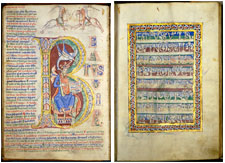Image
© Hildesheim, St Godehard |
PSYCHOMACHIA
ctd, BEATUS VIR
This page is designed
asymmetrically in two blocks: the L-shape for the text, and the rectangle
for the jousting knights, and Beatus Vir. The knights’ position
above the B ties them and their discourse visually and thematically to
the start of the psalms. They are drawn as a light informal sketch, very
close to the trimmed edge of the page and beyond the normally respected
upper margin of the book.
Although the page looks untidy for a frontispiece, it is based on a clear
geometric logic (allowing for a small amount of trimming at the top and
left edge). The B is placed equidistant from top and bottom of the page,
and the horizontal ratio of text to initial is almost exactly 1:2. The
centre point of the entire page, vertically and horizontally, is David’s
right armpit, the fulcrum from which the sounds of the harp are produced.
The last 7 lines of the text describe the initial, explain the benefits
of reading the psalms, and lead the reader directly to the B.
The rather irregular capitals EATUS VIR appear to be added after the page
design was constructed, but before the gilding was finished. The sequence
of activity on this page appears to be as follows:
Draw silvery vertical
and horizontal lines to define space for B, text and horsemen.
- Draw horsemen and B. Paint horsemen and B. Plan to write words in
David’s book.
- Write text, starting on p71 and including rubric in David’s
book. The text space is unruled. The discourse beginning on p71 starts
by mentioning the horsemen ‘who are placed on the other side [of
the page]’, so they were clearly in position before the text began.
Text on p72 has to wrap around the existing finials of the painted B.
Text assumes the rubric in David’s book exists: ‘his own
psalter, in which is written the blessed annunciation’.
- Score/draw orange lines for the insertion of capitals. The upper orange
line is scored level with the painted B, and replaces the silver line
made for the drawn B.
- Draw and paint capitals. These vary considerably in height, from 1.6
to 3cm and are poorly spaced.
- Add gilding to B, in such a way that it overlaps the painted capitals.
- Erase superfluous wording at end of text. According to Pächt,
this was a repeat of the rubric on David’s psalter (AP,
148, n4), but it is no longer legible.
The great B is a well established design.
Interlace binds the bottom and top of the stem which is filled with rather
restrained foliage. The organic exuberance of earlier initials like the
B of the Carilef Bible at Durham (Cathedral Library, A.II.4) has been
tamed, and David fully inhabits his lower part of the letter. He holds
his harp and shows his book open with the words ‘The blessed psalmist
David, whom God has chosen, has gushed forth the annunciation of the Holy
Spirit’. The mighty dove, representing the Holy Spirit, inspires
David through his ear. The bird also inspires David on p56, but not on
p417.
The style of the smaller initials, also found on p73, with their foliate
nodes and flourishes, is very similar to Leiden, Universiteitsbibliothek
B.P.L.114B, 76r and v (Thomson, 1982, pl. 21,22), a copy of Priscian almost
certainly made at St Albans.
Every third line is written in red. The blue and green lines alternate
in such a way that two adjacent lines are never the same colour. The sequence
is R + (BGR/GBR)x3 + (BGR)x12 + G. The capitals also alternate so they
are never the same colour as the rest of the word.
The Spiritual Battle: a discourse
Last page of quire 5

Click to enlarge
|
![]()